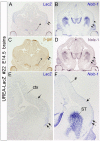Identification of two evolutionarily conserved 5' cis-elements involved in regulating spatiotemporal expression of Nolz-1 during mouse embryogenesis
- PMID: 23349903
- PMCID: PMC3551757
- DOI: 10.1371/journal.pone.0054485
Identification of two evolutionarily conserved 5' cis-elements involved in regulating spatiotemporal expression of Nolz-1 during mouse embryogenesis
Abstract
Proper development of vertebrate embryos depends not only on the crucial funtions of key evolutionarily conserved transcriptional regulators, but also on the precisely spatiotemporal expression of these transcriptional regulators. The mouse Nolz-1/Znf503/Zfp503 gene is a mammalian member of the conserved zinc-finger containing NET family. The expression pattern of Nolz-1 in mouse embryos is highly correlated with that of its homologues in different species. To study the spatiotemporal regulation of Nolz-1, we first identified two evolutionarily conserved cis-elements, UREA and UREB, in 5' upstream regions of mouse Nolz-1 locus. We then generated UREA-LacZ and UREB-LacZ transgenic reporter mice to characterize the putative enhancer activity of UREA and UREB. The results indicated that both UREA and UREB contained tissue-specific enhancer activity for directing LacZ expression in selective tissue organs during mouse embryogensis. UREA directed LacZ expression preferentially in selective regions of developing central nervous system, including the forebrain, hindbrain and spinal cord, whereas UREB directed LacZ expression mainly in other developing tissue organs such as the Nolz-1 expressing branchial arches and its derivatives, the apical ectodermal ridge of limb buds and the urogenital tissues. Both UREA and UREB directed strong LacZ expression in the lateral plate mesoderm where endogenous Nolz-1 was also expressed. Despite that the LacZ expression pattern did not full recapitulated the endogenous Nolz-1 expression and some mismatched expression patterns were observed, co-expression of LacZ and Nolz-1 did occur in many cells of selective tissue organs, such as in the ventrolateral cortex and ventral spinal cord of UREA-LacZ embryos, and the urogenital tubes of UREB-LacZ embryos. Taken together, our study suggests that UREA and UREB may function as evolutionarily conserved cis-regulatory elements that coordinate with other cis-elements to regulate spatiotemporal expression of Nolz-1 in different tissue organs during mouse embryogenesis.
Conflict of interest statement
Figures








Similar articles
-
Ectopic expression of nolz-1 in neural progenitors promotes cell cycle exit/premature neuronal differentiation accompanying with abnormal apoptosis in the developing mouse telencephalon.PLoS One. 2013 Sep 20;8(9):e74975. doi: 10.1371/journal.pone.0074975. eCollection 2013. PLoS One. 2013. PMID: 24073229 Free PMC article.
-
Region- and cell type-selective expression of the evolutionarily conserved Nolz-1/zfp503 gene in the developing mouse hindbrain.Gene Expr Patterns. 2011 Dec;11(8):525-32. doi: 10.1016/j.gep.2011.09.003. Epub 2011 Sep 16. Gene Expr Patterns. 2011. PMID: 21945624
-
Cell type-selective expression of the zinc finger-containing gene Nolz-1/Zfp503 in the developing mouse striatum.Neurosci Lett. 2013 Aug 26;548:44-9. doi: 10.1016/j.neulet.2013.05.020. Epub 2013 May 16. Neurosci Lett. 2013. PMID: 23684982
-
Global gene expression during the human organogenesis: from transcription profiles to function predictions.Int J Biol Sci. 2011;7(7):1068-76. doi: 10.7150/ijbs.7.1068. Epub 2011 Sep 7. Int J Biol Sci. 2011. PMID: 21927576 Free PMC article. Review.
-
Mitochondrial metabolism and the continuing search for ultimate regulators of developmental rate.Curr Opin Genet Dev. 2024 Jun;86:102178. doi: 10.1016/j.gde.2024.102178. Epub 2024 Mar 10. Curr Opin Genet Dev. 2024. PMID: 38461774 Review.
Cited by
-
Whole-Genome Sequencing and Characterization of Buffalo Genetic Resources: Recent Advances and Future Challenges.Animals (Basel). 2021 Mar 22;11(3):904. doi: 10.3390/ani11030904. Animals (Basel). 2021. PMID: 33809937 Free PMC article. Review.
-
Genetic variation of hepatitis B virus and its significance for pathogenesis.World J Gastroenterol. 2016 Jan 7;22(1):126-44. doi: 10.3748/wjg.v22.i1.126. World J Gastroenterol. 2016. PMID: 26755865 Free PMC article. Review.
-
ZNF503 accelerates aggressiveness of hepatocellular carcinoma cells by down-regulation of GATA3 expression and regulated by microRNA-495.Am J Transl Res. 2019 Jun 15;11(6):3426-3437. eCollection 2019. Am J Transl Res. 2019. PMID: 31312355 Free PMC article.
-
Ectopic expression of nolz-1 in neural progenitors promotes cell cycle exit/premature neuronal differentiation accompanying with abnormal apoptosis in the developing mouse telencephalon.PLoS One. 2013 Sep 20;8(9):e74975. doi: 10.1371/journal.pone.0074975. eCollection 2013. PLoS One. 2013. PMID: 24073229 Free PMC article.
-
DNA Conserved in Diverse Animals Since the Precambrian Controls Genes for Embryonic Development.Mol Biol Evol. 2023 Dec 1;40(12):msad275. doi: 10.1093/molbev/msad275. Mol Biol Evol. 2023. PMID: 38085182 Free PMC article.
References
-
- Nakamura M, Runko AP, Sagerstrom CG (2004) A novel subfamily of zinc finger genes involved in embryonic development. J Cell Biochem 93: 887–895. - PubMed
-
- Zhao X, Yang Y, Fitch DH, Herman MA (2002) TLP-1 is an asymmetric cell fate determinant that responds to Wnt signals and controls male tail tip morphogenesis in C. elegans . Development 129: 1497–1508. - PubMed
-
- Weihe U, Dorfman R, Wernet MF, Cohen SM, Milan M (2004) Proximodistal subdivision of Drosophila legs and wings: the elbow-no ocelli gene complex. Development 131: 767–774. - PubMed
Publication types
MeSH terms
Substances
LinkOut - more resources
Full Text Sources
Other Literature Sources
Molecular Biology Databases

